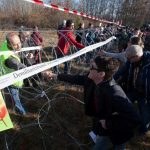After two years of relative calm, the Balkan refugee route seems to be active again.
Seven police administrations covering the border with Bosnia and Herzegovina have received an order to carry out much stricter surveillance of the state border due to the increasing pressure of migrants from Bosnia and Herzegovina who want to enter Croatia, reported Jutarnji List on May 14, 2018.
The police administrations in question are those in Sisak-Moslavina, Karlovac, Lika-Senj, Zadar, Šibenik-Knin, Split-Dalmatia and Dubrovnik-Neretva counties. “Although today’s situation cannot be compared to two years ago, it is still very serious. Over the past few months, about 5,000 migrants have arrived in Bosnia and Herzegovina. Their only goal is to enter Croatia and move on to Western Europe. We have not yet witnessed a massive attempt to enter Croatia. It could be said that migrants are trying to find the easiest way to cross the border. If they find a weak spot, we will face hundreds of migrants trying to break in,” said a police source.
According to unofficial information, Slovenia, Austria and Germany have asked Croatia to increase controls of its border with Bosnia and Herzegovina. Melita Močnik from the Novo Mesto Police Administration in Slovenia said recently that “the Croatian police must pay more attention to border controls with Bosnia, especially in the area of Cazin and Velika Kladuša.”
The new wave of migrants followed the establishment of a new refugee route from Greece, through Albania and Montenegro, to Bosnia and Herzegovina. The route was open after the former Balkan route, which passed through Macedonia, Serbia and Croatia, was closed down after vigorous police action. According to the official statements of the Slovenian police, the pressure on the new route is extreme. In the area of Greece and Albania, there are currently between 50,000 and 60,000 migrants whose only goal is to reach Western Europe.
According to Slobodan Ujić, director of Foreigners’ Department in Bosnia and Herzegovina, in the first ten days of this month about a hundred illegal migrants entered Bosnia and Herzegovina every day. The migrants are mostly from Syria, Libya, Afghanistan, Palestine, Pakistan, Algeria, Morocco, Iraq, Turkey, Iran and Tunisia. They are mainly located in Sarajevo and the area of Velika Kladuša and Bihać, near the Croatian border. The migrants try to pass through Croatia at its narrowest part in the Karlovac region, where just 70 km separate Bosnia and Herzegovina from Slovenia.
According to official data of the Slovenian police, in the first four months of this year, 1,266 migrants were caught trying to illegally enter Slovenia, which is 280 percent more than in the same period last year. They mostly came from Algeria, Morocco and Pakistan.
Unlike the Slovenian police, Croatia has not published any data on the number of migrants. The official position is that there is no migrant problem, and it is virtually impossible to get any official numbers. According to unofficial sources, in the first three months of this year, about 1,300 people were arrested illegally crossing the borders, which is an increase of about 70 percent over the same period last year.
NGOs claim that the Croatian police, after arresting illegal migrants, mostly returns them immediately to Bosnia and Herzegovina in order to avoid a lengthy asylum procedure. The police have denied such allegations.
Croatia could soon also have another significant problem with illegal migrants who will be returned from other EU countries. The Austrian Government has recently adopted a new Aliens Law which stipulates that any person submitting an asylum application who entered the EU through another member state will be immediately returned to that country. According to Austrian media, in the past few months, Austria has been returning to Croatia all migrants for whom it has even the weakest piece of evidence that they had passed through Croatia.
Translated from Jutarnji List (reported by Krešimir Žabec).








